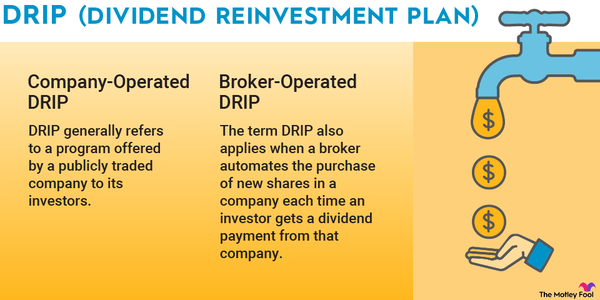A direct stock purchase plan (DSPP) allows you to buy stock shares from the issuing company without a broker. Read on to learn how DSPPs work, what their pros and cons are, and questions you should ask before investing through a DSPP.

Understanding DSPPs
Understanding direct stock purchase plans
DSPPs sell stock shares directly to investors outside traditional brokerage accounts. To invest through a DSPP, you must open an account with the company or its transfer agent, deposit funds or link your bank account, and request a trade. You also have options to set up automated recurring trades and dividend reinvestments.
DSPP trades are usually dollar-based. So, instead of requesting to buy five shares, you'd request to invest $500. In practice, this means you will end up purchasing fractional shares. Fractional shares are simply ownership units that are less than one share.
Say you set up a monthly recurring investment of $100 for a stock priced at $75. Your first transaction would buy you one and one-quarter shares. The one-quarter share is a fractional position. It appreciates and, where applicable, earns proportional dividends.
DSPPs came about in the 1990s as a commission-free alternative to brokerage accounts. In the modern digital era, the cost advantage of DSPPs isn't what it used to be. Still, these programs have features that may be appropriate for some investors.
Pros of DSPPs
Pros of DSPPs
The benefits of DSPP investing include convenience, a dollar-cost-averaging investing style, and easy budgeting.
Convenience: DSPPs support automated investing. That's handy for those who don't want to participate actively in each trade. It also takes the emotion out of investing, making it easier to stick to your program.
Dollar-cost averaging: Dollar-cost averaging (DCA) is the practice of investing a set amount regularly, such as once monthly. An automated and recurring DSPP investment is DCA in action. These repeated, periodic trades reduce the risk of buying at exactly the wrong time. DCA can also keep your average cost lower when stock prices are rising. And a lower average cost means higher gains.
Easy budgeting: Budgeting a set dollar amount for investing is straightforward. Budgeting to buy a set number of shares at an unknown future price is more complicated.
Cons of DSPPs
Cons of DSPPs
The drawbacks of DSPPs are that it's more difficult to diversify in a DSPP, and the shares may be less liquid than positions in your brokerage account.
No diversification: A DSPP gives you access to only one company's stock. However, some transfer agents handle multiple programs. So, you may be able to use one account to join various DSPPs. In that scenario, you would still establish separate recurring investments for each program.
Potentially lesser liquidity: Each plan defines the rules for selling and withdrawing shares. Depending on the plan's rules and the type of account you have, you may be unable to sell shares without transferring them first. If your plan allows you to liquidate, you may not have control over when the transaction is made and at what price.
Questions to ask about DSPPs
Questions to ask about prospective DSPPs
DSPPs and their associated accounts can vary widely in their terms and conditions. These questions highlight the details to define before you sign up.
What are the fees? DSPPs may have fees for opening an account, making trades, and transferring shares.
Where do I open an account? Some DSPPs are run through company accounts, and others use transfer agents. A transfer agent account that provides access to multiple DSPPs is often the best option.
What are the investment minimums? Many DSPPs have minimum opening account balances and minimums for recurring investments.
Can I sell shares directly from my account? Ideally, you'd want the ability to sell shares directly from your account. You're more likely to have this feature in a transfer agent account versus a company account.
How do I transfer shares? At some point, you may want to move your shares to a traditional brokerage account. Make sure you understand the transfer process and any fees you will incur.
DSPP Spotlight: Walmart
DSPP Spotlight: Walmart
Walmart (WMT -0.08%) has a DSPP available through transfer agent Computershare. Computershare also manages DSPPs for Coca-Cola (KO 0.0%), AT&T (T 1.02%), ExxonMobil (XOM -2.78%), Ford (F -1.92%), IBM (IBM -1.05%), McDonald's (MCD -0.91%), and many more.
The program details are as follows:
- Fees: There is a $25 account setup fee to join the program. You'll also pay $1 plus $0.05 per share for each investment if you fund the purchase with a bank debit. There is no fee for reinvesting dividends.
- Account: You'd open an account with Computershare and then join the Walmart DSPP.
- Minimums: New shareholders for Walmart's DSPP must invest $250 to start. You could invest this all at once or set up a recurring $25 investment for 10 transactions.
- Selling shares: You can sell Walmart shares from within the Computershare account. The service is pricey, though. The fees are $25.50 plus $0.05 per share you sell.
- Transferring shares: You can transfer Walmart shares out of the Computershare account by completing an online request form.
As you can see, the DSPP isn't the cheapest way to buy shares of Walmart, especially if you plan on selling eventually. Like many DSPPs, this program is geared for long-term, hands-free investors who want to build positions in specific companies over time.




















































